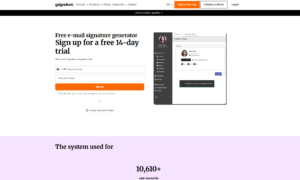In the professional landscape, an email signature serves as a digital business card, leaving a lasting impression on recipients. To create a signature that reflects your brand identity and stands out, using an HTML editor is essential. However, with a plethora of options available, choosing the best HTML editor for your email signature can be a daunting task. In this post, we’ll look at some of the best indicators on choosing the best editor for your needs.
Customization Options
A robust HTML editor should provide extensive customization options. Your email signature is an extension of your professional identity, so it’s crucial to choose an editor that allows you to tailor every aspect. Ensure the editor supports various formatting options, font styles, colors, and the inclusion of images or logos. This flexibility enables you to create a signature that aligns with your brand guidelines.
If you’re looking for an HTML editor for email signature, look for one that has a load of features. Bybrand for example, can be the best choice as it provides superior features like editing from scratch, converting text to HTML, cropping image, editor in HTML mode, and so much more.
User-Friendly Interface
One of the first factors to consider is the editor’s user interface. The best HTML editor for an email signature should offer a user-friendly experience, allowing both beginners and experienced users to navigate effortlessly. Look for features like drag-and-drop functionality, intuitive controls, and real-time previews to streamline the signature creation process.
Responsiveness
In an era where emails are accessed on various devices, including smartphones and tablets, it’s imperative that your email signature looks polished across all screen sizes. Choose an HTML editor that generates responsive code, ensuring your signature adapts seamlessly to different devices. This guarantees a consistent and professional appearance, regardless of the recipient’s preferred platform.
Compatibility with Email Clients
Email clients vary in their rendering of HTML code, and what looks fantastic in one may appear differently in another. A reliable HTML editor for email signatures should generate code that is compatible with popular email clients. Test the signature across different platforms to ensure it maintains its integrity and visual appeal, regardless of where it’s viewed. Always make sure that compatibility is never a problem.
Remember, if a client can’t open something because of compatibility issues, they might pass on your email. It’s always frustrating when this happens, as something as small of an issue like this would’ve been addressed earlier had compatibility been checked.
Security Considerations
Security is paramount, especially when embedding HTML code into your email signature. Opt for an html formatter online that prioritizes security measures, preventing any vulnerabilities that could be exploited. This includes ensuring the editor doesn’t allow the insertion of malicious code and adheres to industry standards for email security.
Integration Capabilities
Consider an HTML editor that seamlessly integrates with your email platform. Integration features can simplify the process of applying and updating your signature directly within your email settings, saving you time and effort. Look for compatibility with commonly used email platforms such as Gmail, Outlook, or other providers your organization uses.
Collaboration Features
For businesses with multiple team members, collaboration features become crucial. A good HTML editor should facilitate collaboration, allowing team members to work on a signature simultaneously or share templates easily. This enhances consistency in branding across the organization.
Conclusion
Choosing the best HTML editor for your email signature is a crucial step in presenting a professional image to your recipients. Consider factors such as user-friendliness, customization options, responsiveness, compatibility, security, integration capabilities, and collaboration features.
By evaluating these aspects, you can make an informed decision that aligns with your brand identity and ensures a seamless experience for both you and your email recipients. Remember, a well-crafted email signature is not just a sign-off; it’s a representation of your professionalism and attention to detail.



































